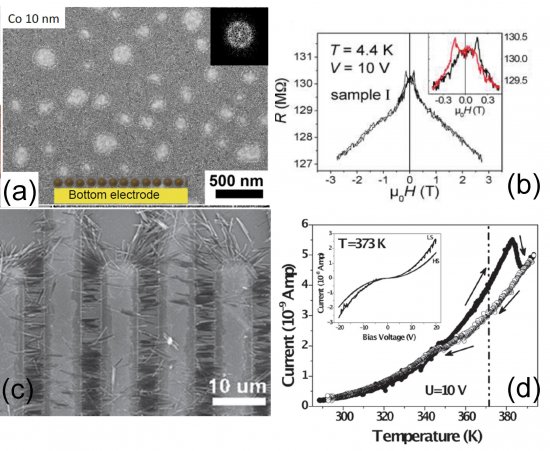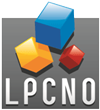Electronic properties and magnetoresistance
Our overall goal in this topic is the study of the transport and magnetotransport properties of chemically-synthesized objects in order to evaluate their properties in spintronics. In 2009, we installed in our laboratory thin film deposition setup combined with a glove box. We have developed in this setup all the protocols necessary for the integration of air-sensitive nano-objects in electronic devices. We successfully integrated nano-objects within the electrodes by two complementary approaches: i) by dip-coating on substrates (see Fig. 1 (a)), or ii) between electrodes by dielectrophoresis (see Fig. 1 (c)). The ability to perform basic transport measurements inside the glove box and the presence of an optical microscope permits to check the quality of the deposits. We have also developed various types of electrodes on the RTB platform (LAAS, Toulouse): interdigited combs, electrodes with gap, etc …

These integration methods were used to elaborate different types of samples based on magnetic nano-objects, which have subsequently been measured in transport and / or magnetotransport. It may be noted three outcomes of interest:
– Observation of tunnel magnetoresistance on assemblies of iron nanoparticles, persisting up to room temperature. This result could be achieved only after the optimization of the nano-objects synthesis and of their surface ligands. It required significant work of magnetic analysis (Mössbauer, SQUID) and transport measurements from the team (see Fig. 1 (c)).
– The control of the electronic coupling between Co nanoparticles by varying the length of their ligands. Transport in these assemblies was analyzed quantitatively by the theory of inelastic cotunneling.
– More recently, in collaboration with the team of A.. Bousseksou (LCC Toulouse), we were able to electrically contact spin crossover nano-objects. Thus, we were able to detect the spin transition through a change in resistance for transition temperatures slightly above room temperature (see Fig 1 (d)).
These results demonstrate the value and potential of these nano-objects for spintronics.
